How long does it take to drive around Iceland?
By Michael Chapman
Iceland boasts landscapes of immeasurable beauty, with each region considered a treasure-trove of splendid sights and unique scenery.
Guests looking to draw all they can from their holiday in Iceland will, in no uncertain terms, want to rent a vehicle. Doing so will provide them ample freedom to discover the breadth of this country’s landscape, plus allows for that untethered, exploratory mindset so necessary for maximising one's time here.
Whether in a car, motorhome or minivan, driving is, hands down, the best way to experience this country. Nowhere else on earth can compare to the sheer diversity of this land’s nature, regardless of what season you choose to visit, so make sure to select a comfortable ride that won’t detract from the incredible views as they pass by.

After leaving the departure lounge of Keflavik International Airport, most visitors begin their journey in the capital city, Reykjavík, located in West Iceland. While many choose to pick up their rental car at the airport, there are options available to those who would like to collect in the city.
Despite it being the sole contender, Reykjavík makes for a fantastic place to spend a few days before setting out on your adventures. Make sure to stop in at some of the city’s biggest highlights, including Hallgrimskirkja Lutheran Church, Perlan Museum and Observation Deck and, of course, the bustling Laugavegur shopping street.
In light of this article’s subject, however, we’ll be heading off right away.
What is the Ring Road in Iceland?
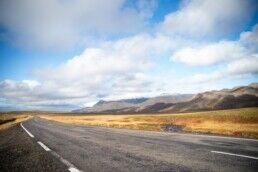
Those looking to circumnavigate Iceland in its entirety will want to take the famous Ring Road, otherwise known as Route 01, which was only completed as recently 1974. This intrepid, two-lane motorway constitutes the heart of all Icelandic road trips, covering a total distance of 1322 kilometres (821 miles), roughly equivalent to the length travelled from one end of the UK to the other.
Driving the Ring Road is tantamount to tackling Route 66 in the United States, such is its growing popularity among tourists from both sides of the Atlantic. From the passenger seat window, you are sure to pass a wealth of memorable sights, from herds of Icelandic horses to scenic promenades and distant mountainscapes. Every bend of the road, every twist of the trail, promises to snatch your breath away, so be sure to soak up every moment of your time on the road.
Which direction shall I travel on the Ring Road in Iceland?

Guests will usually travel east from Reykjavík, following the picturesque coastal route that snakes through South Iceland’s hillsides.
This direction leads to the dramatic Eastfjords, home to Vestrahorn mountain, before curling back along the northern shorelines. Eventually, the Ring Road descends through West Iceland, passing by the Snæfellsnes Peninsula, before concluding at Reykjavík once more.
While this counterclockwise direction is what most visitors and tour operators choose to follow, there is nothing from stopping anyone seeing the attractions in reverse, starting with those found in the west, and ending with those in the south.
Why is the Ring Road in Iceland so famous?
The reasons behind the Ring Road’s fame—aside from its obvious utility—are twofold. The first is that many of Iceland’s most famous natural attractions can be found right alongside, or nearby, to the road itself.
Travellers en route can expect to find the glittering icebergs of Jökulsárlón glacier lagoon, the picturesque cascades of Seljalandsfoss and Skógafoss waterfalls, and the black pebbles of Reynisfjara beach. And that’s just the South!

Further north, the volcanic landscapes of Lake Mývatn await you, as does the epic Dettifoss waterfall. Opportunities to explore Iceland’s unofficial ‘Northern Capital,’ Akureyri, is also on the cards, plus stops at Goðafoss waterfall and the impressive Hvítserkur rock stack.
The second reason behind the Ring Road’s fame goes beyond specific attractions, instead focusing on the broad variety of landscapes it covers. Think, if you will, of how elegant the manner in which the south’s sea cliffs and stark volcanic deserts merge into the emerald meadows and epic fjords of North Iceland. Such scenery is commonplace in fantasy novels; in reality, it is something else entirely.
Glaciers and mountain ranges are everyday staples for drivers on the Ring Road, not mentioning the array of quaint seaside towns, rustic farmsteads and authentic turf houses that make up the lower scenery.
As its name suggests, the Ring Road connects all of Iceland’s coastal settlements, save for those found on islands, in the remote Westfjords or on the Snæfellsnes Peninsula. Route 01 surrounds the uninhabitable Highlands area; which can only be accessed during the summer with a professional tour operator.
How long does driving the Ring Road in Iceland take?
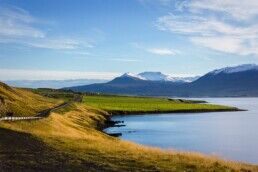
It is possible to complete a full trip of the Ring Road in just under seventeen hours. However, this is only achievable with nonstop driving; thus, it is not seen as either a safe or fun means of experiencing what should be a once-in-a-lifetime trip. Instead, the exact length of time you’ll spend on the road depends on several factors.
- Which season will you visit Iceland?
- Which attractions will you be visiting during your travels?
- What length of time will you be spending at each attraction?
- Will you stop overnight?
- What time will you set out and retire each day?
Essential questions such as these should be considered part-and-parcel of your holiday preparations.
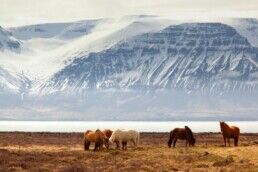
Most travel providers in Iceland recommend that visitors take 7 to 14 days to complete the Ring Road. This allotment is considered ample time to enjoy the fabulous attractions that each region offers and factors in a few locations that divert from Route 01 itself, including Snæfellsnes, the Westfjords and towns like Húsavík, the ‘Whale Watching Capital of Europe.’
Also keep in mind that you’ll be making frequent stops that have no name, but demand appreciation all the same. Given the sheer number of pit stops and viewpoints along the way, you’ll want to keep your camera at the ready so as not to miss out on some prized contributions to the holiday album. Consider adding a few extra days to your vacation time if you think of yourself as something of a shutterbug.
Should I drive around Iceland in Winter or Summer?

Another crucial factor contributing heavily to how much time you’ll spend on the road is the weather. This is contingent on your travel plans, with each season showcasing Iceland in a dramatically different light.
Summer travellers—those visiting Iceland between April to September—will have an easier time driving on the roads, unhindered by a lack of low-visibility, rough weather and snowfall. Instead, the mid-year will bless them with extra daylight hours courtesy of the Midnight Sun, as well as clear panoramas of the surrounding countryside.
Given these facts, summer guests can expect to arrive quicker to each destination, though they will likely spend more time appreciating the sites outside their vehicle. June, July and August should also be accounted for specifically given these constitute the ‘high tourist season’ in Iceland, meaning the roads and attractions will be busier.

Visitors in the winter (those arriving between September and March) are urged to drive very slowly and carefully, regardless of how conditions may appear from the window. Though the Ring Road is tarmacked and routinely salted during this time of year, there cannot be enough emphasis put on just how unpredictable and unruly Iceland’s weather can be.
For example, previous guests to this stunning, yet often hostile land have described winter driving here as akin to piloting the Millenium Falcon during a jump to hyperspace. As such, extra care on the road must be respected at all times, even if it is at the expense of your schedule.
None of this is to say that taking to the Ring Road during winter isn’t worth it. There are many draws and benefits to doing so, the most prominent being the Northern Lights. Nothing can describe the rewarding feeling that comes with witnessing this vibrant and otherworldly phenomenon; ribbons of light and colour, swathing the skies above you, dancing in such a way as to seem almost conscious.
How fast can I go on the Ring Road in Iceland?
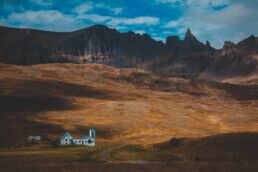
The speed limit for most of the Ring Road is 90 kilometres per hour (55 miles per hour). However, there are sections of the route where you will need to take things slower, namely gravel roads, where the speed limit is 80 kilometres per hour (50 miles per hour), and urban areas, which level off at 50 kilometres per hour (30 miles per hour.)
It is also important to be extra vigilant during the summer when sheep are allowed free-roam of the island. While cute, and undoubtedly useful for Iceland’s continued growth, the sheep here are not considered exceptionally bright animals, but rather, ones a little too comfortable standing close to the roadside.
Always be aware that, at one point or another, it’s likely you’ll have to slow your vehicle down to avoid hitting the local wildlife. Also note that Iceland has several one-lane bridges that, once again, will require you to watch your speed.
It is a fair estimate that guests could comfortably travel between 200 kilometres to 300 kilometres a day. This pace avoids rushing from spot to the next, allowing for a much more relaxed experience all-round. On that note; getting boisterous with the acceleration should be avoided at all costs. Speed cameras are numerous along these popular routes, and the fines here are, shall we say, more than a little hefty.
Are there gas stations on the Ring Road in Iceland?
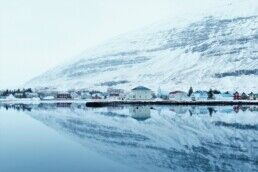
Gas stations are found in most towns along the Ring Road, though they are notably less frequent in the countryside. These long stretches in between can worry some travellers, but a little preparation is all that’s necessary to alleviate any concern.
Iceland is one of the most sparsely populated nations on earth, so settlements can be many hundreds of kilometres apart from another. It is recommended to always top-up fuel whenever the opportunity arises, and schedule in known stops along the way to avoid getting stuck in the middle-of-nowhere.
Gas is considered on the expensive side in Iceland. As of 2021, you can expect anywhere from 203 – 238 ISK (roughly 1.5 to 1.8 USD) per litre of fuel. If you happen to be planning a more ambitious trip where you expect to divert often, then keeping a spare fuel canister in your vehicle might be considered good advice.
How long to travel the South Coast in Iceland?

Of course, not all travellers will have the time required to see all of Iceland during one trip, and therefore will need to concentrate on individual sections of the country. South Iceland is considered top among the regions for the diversity of its attractions, so should be high on the list of any prospective traveller.
Reynisfjara black sand beach is one such sight, attracting visitors with its unruly grey waves and towering basalt columns. Now famous the world over for its haunting ambience, the beach sits just beneath Vík í Mýrdal coastal village, roughly 187 kilometres (116 miles) east of Reykjavík.
There are many sites en route to Vík worthy of a stop, including the famed waterfalls Seljandsfoss and Skógafoss, and the Dyrhólaey promontory, best known for its steep bird cliffs and photogenic lighthouse.
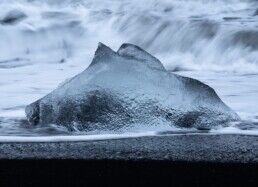
As part of Vatnajökull National Park, Jökulsárlón glacier lagoon is considered the last attraction that constitutes as being within South Iceland.
Reaching this beloved water body requires a drive of 379 kilometres (236 miles), which takes around 6 hours with stops included on the way. Though the length of time driving is not to be sniffed at, it is possible for visitors to make it to and from Reykjavík to Jökulsárlón in a single day. While this is not recommended, it may come as some relief for those with only hours in the country to spare.
If you are hoping to spend more time amidst the majesty of Vatnajökull National Park, then it is highly advised that you stay overnight in the area.
How long to travel the Golden Circle sightseeing route in Iceland?
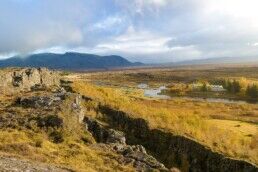
The Golden Circle is Iceland’s most famous sightseeing route, and can easily be seen in a day by guests from Reykjavík. Made up of three major attractions, the Golden Circle is recommended above all else for those with only limited time in the country. All in all, the route can be completed in around eight hours, considering that guests will spend some time at each site.
A forty-minute drive from the city will take you to the UNESCO World Heritage site, Þingvellir National Park. While gazing out from the viewpoint atop Almannagjá fault, you’ll undoubtedly ponder on the rich history of this mystic place. Þingvellir is where the world’s oldest parliamentary democracy, the Alþingi, was formed in 930 AD, making it one of the most notable locations in Icelandic history.
The entire area is found atop a geological anomaly known as the Mid-Atlantic Ridge. Impressive in its own right, guests here can witness the North American and Eurasian tectonic plates exposed from the ground. This unique geology has created an alien paradise on the banks of Lake Þingvallavatn, complete with moss-laden rocks and trickling glacial springs.
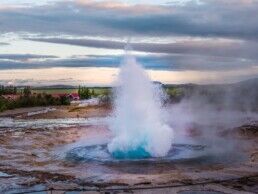
After exploring Þingvellir National Park, you will travel to Haukadalur geothermal valley, home to the spectacular Strokkur geyser. Every ten minutes or so, this powerful hot spring jettisons boiling water up to twenty-five metres in the air, culminating in what can only be described as a true spectacle of nature.
Also on site is Geysir. This now dormant hot spring lent its name to geysers around the world when it was first documented in the 18th century. Aside from Strokkur and Geysir, there are a number of other bubbling mud pools and steaming fumaroles in the vicinity.
The mighty waterfall, Gullfoss, makes up the final third of the Golden Circle route. It is, arguably, the most dramatic of all the attractions listed so far. Descending a total of thirty-two metres over two rocky ‘steps’, this giant feature emanates a constant plume of steam that cloaks the entire area, as well a continual guttural roar that can be heard from miles away.
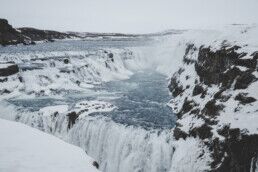
End of the Road
In summary, you can drive around Iceland using the Ring Road in a single day, though this is strongly advised against on account of your enjoyment and safety. We’re not trying to break records here, people; instead, we want every second of our time in Iceland to count.
Take one, two or even three weeks to fully immerse in all the sights, sounds and activities that can be found circumnavigating this awe-inspiring island.
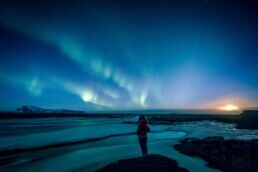
Other popular sightseeing routes in Iceland can be seen in less time, including the South Coast, the Golden Circle and even the Snæfellsnes Peninsula. To make it clear, we do recommend staying at least one night on the road while exploring South Iceland and beyond. West Iceland and Snæfellsnes, on the other hand, can often be experienced in a single day trip respectively.
However you choose to discover Iceland, there is no doubt that it will be one of your life’s most memorable adventures. With that in mind, give yourself enough time in the country to leave the capital and seek out all that makes this country so special. We promise you won’t regret doing so.